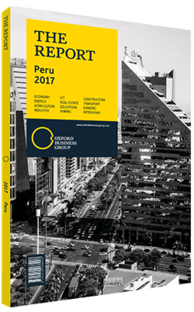Real estate presents a major investment opportunity
Over the past five years growth in the real estate sector has outpaced that of the economy as a whole, driven by increasing household income levels; pent-up demand, particularly among middle- and middle-low-income households; greater access to mortgages due to lower interest rates; and state housing programmes such as the My House fund. However, in 2016 a number of factors affected the performance of the real estate sector, including stricter conditions for mortgage loans, especially for lower-income applicants; a slowdown in employment growth; a three-year decline in private investment; and a depreciation of the exchange rate, thereby raising the value of homes priced in US dollars.
As a result, building activity was down 4.2% year-on-year (y-o-y) in the Lima-Callao Metropolitan area in July 2016, which covers an area of 5.7m sq metres, according to the “21st Market Study of Urban Buildings in Lima and Callao”, conducted by the Peruvian Chamber of Construction (Cámara Peruana de la Construcción, CAPECO). The CAPECO study also stated that the decline in construction growth was led by office space, which fell by 19.5%, followed by construction of commercial establishments, down 11.5%. Hotels, schools, movie theatres, restaurants and others also saw a contraction of 7.1%. Home construction rose by nearly 1%; however, even though homes represent 65.7% of total construction activity, this slight increase was not enough to offset the declines in other segments, such as the 12.5% and 1.2% contractions in office space and commercial establishments, respectively. The number of new homes sold fell by 2.7%, while homes available for sale increased 3.2% y-o-y. As a result, the total supply in the Lima-Callao Metropolitan area increased by 1.3% y-o-y to 35,350 houses as of July 2016.
Rising Prices
A recent increase in the price of land, along with robust demand for homes, has driven the average price per sq metre for residential apartments up in Lima. However, this trend has reversed in the past two years. The average price in July 2016, the most recent period for which data is available, was $1446, down 6% y-o-y. However, this was still 43% greater than in July 2011. In high-income districts the average price per sq metre of residential apartments remains above the average price for the city of Lima as a whole.
These historically high land and residential prices have caused some concern over the possibility of a real estate bubble. However, the prices of residential properties reflect fundamentals, especially the relatively low availability of land in the Lima metropolitan area. In addition, land prices in Lima are still low compared to other major Latin American cities. According to the Global Property Guide, Peru has one of the lowest prices per constructed sq metre in the region. The average price in Peru ($1845) is lower than that of Panama ($2370), Colombia ($2479), Uruguay ($2598), Brazil ($2651), Chile ($2771), Argentina ($2813) and Mexico ($2917), among several others.
Property Yields
The real estate sector’s price-toearnings ratio, calculated by Peru’s central bank, was 17.7x in the fourth quarter of 2016. This is well within the normal range and is significantly lower than the 25x threshold, above which properties are considered overpriced. There are, however, certain areas of Lima in which this indicator is closer to 20.
According to the CAPECO study, in July 2016 residential construction activity in the Lima-Callao Metropolitan area totalled 3.8m sq metres, in line with figures for July 2015. Pending homes for sale amounted to 24,519 units, up 3% on 23,761 units in the same period of 2015. Some 10,822 new homes were sold, down nearly 3% y-o-y from 11,118. Total effective demand in the Lima-Callao Metropolitan area reached 474,000 homes in July 2016, which suggests there is still significant potential for growth in the lower-income segments.
However, household income levels have not been improving as much as in previous years. For the price trend in land and homes to resume an upward trend, it would require that income levels begin rising again.
You have reached the limit of premium articles you can view for free.
Choose from the options below to purchase print or digital editions of our Reports. You can also purchase a website subscription giving you unlimited access to all of our Reports online for 12 months.
If you have already purchased this Report or have a website subscription, please login to continue.

